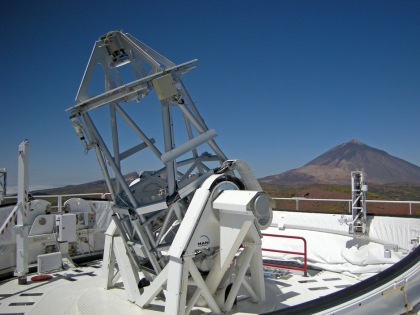Press Release 03/2012 - Mai 15, 2012
GREGOR: German astronomers finish Europe's largest solar telescope on Tenerife
The Max Planck Institute for Solar System Research is partner of the GREGOR-project. The inauguration ceremony will take place on May 21st, 2012.
After ten years of development, the new German solar telescope GREGOR will start operating at the Spanish Observatorio del Teide of the Instituto de Astrofísica de Canarias on Tenerife. It is the largest solar telescope in Europe and number three worldwide. It will provide the German and the international community of solar physicists with new and better instrumentation which will enable them to investigate our home star in unprecedented detail. Studying the Sun is a key to understand the physical processes on and in the majority of stars. Moreover, there is also a very practical aspect: the solar activity affects or even damages satellite systems and power networks in some regions on Earth. Knowing more about it may help to mitigate expensive damages. The inauguration ceremony will take place on May 21, 2012 on Tenerife.
GREGOR is a solar telescope with an aperture of 1.5 meters and has been designed to carry out observations of the solar photosphere and chromosphere in the visible and infrared part of the spectrum. Due to its large diameter it will allow observations with higher resolution than was possible before. A novel "adaptive optics system" is able to compensate for atmospheric disturbances and provides a detailed image of the Sun, similar to what would be achieved if the telescope was in space. The resulting high spatial, spectral, and temporal resolution will allow scientists to follow physical processes on the Sun on spatial scales as small as 70 km.

|
Figure 1: The inauguration ceremony for Europe's largest solar telescope GREGOR will take place on May 21st, 2012.
|
(Credits: Kiepenheuer-Institut für Sonnenphysik)
|
During night time GREGOR can also observe bright stars. It will mainly be used for long term monitoring of stars in order to find out whether the distant suns show similar cyclic behaviour as our own.
GREGOR's design is completely open in order to enable wind cooling of the telescope structure and the mirrors. The classical dome has therefore been replaced by a retractable structure which allows natural air flushing. This open structure places high demands on the mechanical stability of the telescope structure in order to eliminate wind-induced vibrations.
The primary mirror is a lightweight filigree structure made of a special material that does not deform under the heat of the bright Sun. Additionally, the mirror is actively cooled from the back in order to prevent the front side from heating up and thus producing internal turbulence.
From the telescope the light is guided into the laboratory rooms where it can be distributed to a number of analyzing instruments:
- An imaging setup produces images of the solar surface at various wavelengths. These images are expected to show an extraordinary richness of details.
- Studying the photosphere and chromosphere of the Sun, analyzing the interaction of the solar magnetic field and the highly dynamic plasma, will be possible thanks to the interferometric setup.
- A spectrograph will analyze the solar atmosphere by looking into the near infrared part of the spectrum. It will be able to produce detailed maps of the solar magnetic field.
GREGOR will be accessible to the international solar physics community and has the potential to provide a significant boost to solar physics worldwide.
The GREGOR solar telescope has been built by a German consortium under the leadership of the Kiepenheuer-Institut für Sonnenphysik in Freiburg with the Leibniz-Institut für Astrophysik Potsdam and the Max Planck Institut for Solar System Research in Katlenburg-Lindau as partners, and with contributions by the Instituto de Astrofísica de Canarias, the Institut für Astrophysik Göttingen, and the Astronomical Institute of the Academy of Sciences of the Czech Republic.
Images and und Background Information
 Structure of the telescope, mirror, building, observatory, and surrounding area, Teneriffa
Structure of the telescope, mirror, building, observatory, and surrounding area, Teneriffa
 Pictures from the inauguration ceremony on May 21, 2012
Pictures from the inauguration ceremony on May 21, 2012
 VIDEO: Background information on GREGOR
VIDEO: Background information on GREGOR
 Essay: Zooming in on the Sun
Essay: Zooming in on the Sun
 Poster: The Solar Chromosphere with GREGOR
Poster: The Solar Chromosphere with GREGOR
Further Information
 GREGOR telescope
GREGOR telescope
 Kiepenheuer-Institute für Sonnenphysik Freiburg
Kiepenheuer-Institute für Sonnenphysik Freiburg
 Leibniz-Institut für Astrophysik Potsdam (AIP)
Leibniz-Institut für Astrophysik Potsdam (AIP)
 Observatorio del Teide
Observatorio del Teide
 Solar Lower Atmosphere and Magnetism at MPS
Solar Lower Atmosphere and Magnetism at MPS
Contact
Dr. Birgit Krummheuer
Press and Public Relations
Max Planck Institute for Solar System Research
Max-Planck-Straße 2
37191 Katlenburg-Lindau
Tel.: 05556 979 462
Fax: 05556 979 240
Mobil: 0173 3958625
Email: krummheuer mps.mpg.de
mps.mpg.de
Prof. Sami K. Solanki
Max Planck Institute for Solar System Research
Max-Planck-Straße 2
37191 Katlenburg-Lindau
Tel: 05556 979 325
Email: solanki mps.mpg.de
mps.mpg.de
Dr. Andreas Lagg
Max Planck Institute for Solar System Research
Max-Planck-Straße 2
37191 Katlenburg-Lindau
Tel: 05556 979 465
Email: lagg mps.mpg.de
mps.mpg.de
